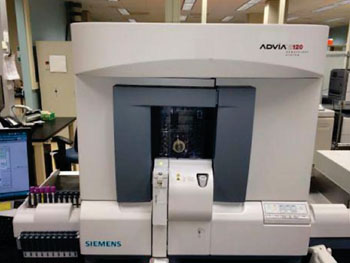Preoperative Blood Cell Ratios Predict Endometrial Cancer Survival
By LabMedica International staff writers
Posted on 03 Aug 2015
The variations in systemic inflammatory response biomarker levels have been associated with adverse clinical outcome in various malignancies and the host response to malignant tumors is characterized by systemic inflammation, resulting in a relative thrombocytosis, neutrophilia and lymphocytopenia. Posted on 03 Aug 2015
Biomarkers of systemic inflammation such as elevated neutrophil:lymphocyte ratio (NLR), platelet:lymphocyte ratio (PLR) and absolute monocyte counts have shown potential for guiding the clinical management of cancer patients across a range of malignancies including endometrial cancer.

Image: The ADVIA 2120 Hematology System (Photo courtesy of Siemens).
Scientists at St James’s University Hospital (Leeds, UK) performed a retrospective study examining the records of a sequential series of 733 patients with a new diagnosis of primary endometrial cancer between January 2005 and December 2007. Patients’ full blood count data, including absolute leukocyte, neutrophil, eosinophil, basophil, monocyte, lymphocyte and platelet counts, were collected from a time frame of less than two weeks prior to hysterectomy and used to calculate NLR, PLR and monocyte:lymphocyte (MLR) ratios. The investigators chose to calculate MLR, the reciprocal of the more frequently used lymphocyte:monocyte ratio (LMR), to standardize by dividing myeloid lineage counts by lymphoid lineage cell counts for all relevant variables.
Full blood counts were performed on the Advia 2120 hematology analyzer (Siemens; Erlangen, Germany). The team applied cut-offs of greater than or equal to 2.4 (NLR), greater than or equal to 240 (PLR) and greater than or equal to 0.19 (MLR). NLR and PLR, but not MLR had independent prognostic significance. They combined NLR and PLR scores and stratified patients into low (NLR-low and PLR-low), intermediate (NLR-high or PLR-high) and high risk (NLR-high and PLR-high) groups. Increased NLR and PLR were most strongly associated with advanced stage, whereas increased MLR was strongly associated with older age. Both NLR and PLR were identified as having independent prognostic value when adjusted for age, stage, grade, lymphovascular space invasion and histopathological subtype.
The authors concluded that they have highlighted the potential of NLR and PLR as additional prognostic tools and despite their inter-relationships, both NLR and PLR proved to be better prognostic indicators than MLR in endometrial cancer. These are simple measures which are essentially cost-neutral and which could aid decision-making in the clinical management of endometrial cancer patients. The study was published on June 16, 2015, in the British Journal of Cancer.
Related Links:
St James’s University Hospital














